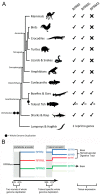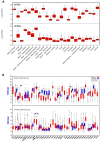The Reprimo Gene Family: A Novel Gene Lineage in Gastric Cancer with Tumor Suppressive Properties
- PMID: 29941787
- PMCID: PMC6073456
- DOI: 10.3390/ijms19071862
The Reprimo Gene Family: A Novel Gene Lineage in Gastric Cancer with Tumor Suppressive Properties
Abstract
The reprimo (RPRM) gene family is a group of single exon genes present exclusively within the vertebrate lineage. Two out of three members of this family are present in humans: RPRM and RPRM-Like (RPRML). RPRM induces cell cycle arrest at G2/M in response to p53 expression. Loss-of-expression of RPRM is related to increased cell proliferation and growth in gastric cancer. This evidence suggests that RPRM has tumor suppressive properties. However, the molecular mechanisms and signaling partners by which RPRM exerts its functions remain unknown. Moreover, scarce studies have attempted to characterize RPRML, and its functionality is unclear. Herein, we highlight the role of the RPRM gene family in gastric carcinogenesis, as well as its potential applications in clinical settings. In addition, we summarize the current knowledge on the phylogeny and expression patterns of this family of genes in embryonic zebrafish and adult humans. Strikingly, in both species, RPRM is expressed primarily in the digestive tract, blood vessels and central nervous system, supporting the use of zebrafish for further functional characterization of RPRM. Finally, drawing on embryonic and adult expression patterns, we address the potential relevance of RPRM and RPRML in cancer. Active investigation or analytical research in the coming years should contribute to novel translational applications of this poorly understood gene family as potential biomarkers and development of novel cancer therapies.
Keywords: biomarker; development; evolution; gastric cancer; reprimo; tumor suppressive gene properties.
Conflict of interest statement
The authors declare no conflict of interest.
Figures






References
-
- Wichmann I.A., Zavala K., Hoffmann F.G., Vandewege M.W., Corvalan A.H., Amigo J.D., Owen G.I., Opazo J.C. Evolutionary history of the reprimo tumor suppressor gene family in vertebrates with a description of a new reprimo gene lineage. Gene. 2016;591:245–254. doi: 10.1016/j.gene.2016.07.036. - DOI - PubMed
-
- Saavedra K., Valbuena J., Olivares W., Marchant M.J., Rodriguez A., Torres-Estay V., Carrasco-Avino G., Guzman L., Aguayo F., Roa J.C., et al. Loss of expression of reprimo, a p53-induced cell cycle arrest gene, correlates with invasive stage of tumor progression and p73 expression in gastric cancer. PLoS ONE. 2015;10:e0125834. doi: 10.1371/journal.pone.0125834. - DOI - PMC - PubMed
Publication types
MeSH terms
Substances
LinkOut - more resources
Full Text Sources
Other Literature Sources
Medical
Molecular Biology Databases
Research Materials
Miscellaneous

